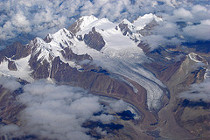Man-made cloud of soot melting Himalayan glaciers
Climate researchers conclude that particles of soot emanating from Europe to South Asia are accelerating the melting of Himalayan glaciers.

 Climate researchers conclude that particles of soot emanating from Europe to South Asia are accelerating the melting of Himalayan glaciers. Many studies suggest that the Himalayan glaciers have been shrinking over the past few decades. This has usually been attributed to rising air temperatures, but studies suggest that tiny airborne particles of soot and dust are also to blame. The dark fragments absorb sunlight, which warm their surroundings.
Climate researchers conclude that particles of soot emanating from Europe to South Asia are accelerating the melting of Himalayan glaciers. Many studies suggest that the Himalayan glaciers have been shrinking over the past few decades. This has usually been attributed to rising air temperatures, but studies suggest that tiny airborne particles of soot and dust are also to blame. The dark fragments absorb sunlight, which warm their surroundings.
Figures corroborated by a study led by Xu Baiqing of the Chinese Academy of Sciences' Institute of Tibetan Plateau Research, in Beijing suggest the soot could reduce the glaciers' ability to reflect light by 2-5 per cent. This could increase the amount of melting by 12-34 per cent.
Angela Marinoni of the Institute of Atmospheric Sciences and Climate in Bologna has helped to build a series of cutting-edge weather stations in the Nepalese Himalayas, allowing her to witness climate change at first hand. Marinoni has been involved in the Nepal Climate Observatory - Pyramid, in the Khumbu valley, which began a full-time study of aerosol particles, including soot, in 2006.
Even at altitudes above 5,000 metres, soot is widespread, and when it lands on glaciers it accelerates their melting, research has found.
"The Pyramid is jointly run with the Nepal Academy of Science and Technology. We have training courses to improve the scientific and technical capacity of the local community. A central mission of the Pyramid is to better understand the impact of anthropogenic activities, especially pollutant transport and deposition, on water resources in the region," said Marinoni in an interview with Nature News.
The glaciers sustain around 1.5 billion people by feeding Asia's largest rivers. The worry is not that the Himalayan glaciers will disappear, despite a mistake in a report by the Intergovernmental Panel on Climate Change suggesting that this might happen quickly. Rather, a main concern is that accelerated melting induced by this soot could cause flooding.
Soot is expected near cities and in regions like South-East Asia, where people are clearing vegetation by burning it, but the dispersion of pollution has surprised climate researchers. Marinoni explained to an audience at the 2nd Third Pole Environment Workshop in Kathmandu on October 27th 2010 that the high Himalayas are under an onslaught from this sort of pollution.
The team's initial intention was to take advantage of what they assumed would be the pristine conditions found at 5,079 metres above sea level, measuring typical background conditions of the atmosphere. Instead, they were surprised to find a thick haze, loaded with soot, smothering the mountain slope, said Marinoni. In the rainless pre-monsoon months between January and May, about one day in five saw the Khumbu valley blanketed in a thick dirty cloud.
By analysing atmospheric circulation patterns, the research team found that winds could bring pollution from as far away as Europe, the Middle East and North Africa. The Himalayan valleys act as chimneys, pumping dust and soot from the Indian plains to mountain summits.
A team led by Dr Xu Baiqing drilled cores from the ice of five Tibetan glaciers in order to examine the past few decades' worth of pollution. These cores show that the level of pollution, especially soot, in Himalayan glaciers correlates with emissions in Europe and South Asia.
In the north-west and centre of the Tibetan plateau Dr Xu and his team found that particularly high levels of soot had fallen on the glaciers during the 1950s. Westerly winds frequent these regions, indicating that the soot in question originated in Europe. The observation that soot levels fell during the 1970s, a period when many European countries enacted clean-air regulations, supports this hypothesis.
Conversely, the glaciers in the south-eastern part of the plateau were found by Dr Xu to hold high concentrations of soot – with figures rising by 30 per cent between 1990 and 2003. This phenomenon in the region downwind of the Indian subcontinent coincides with a period of rapid industrial growth in India.
Work done at the Pyramid centre is anticipated to benefit the local community in Nepal. Future plans include adding additional instruments for ultraviolet and carbon monoxide measurements. "We are also testing a portable climate station that can take basic meteorological measurements as well as monitor ozone and aerosols," Marinoni told Nature News. Very little is still known about the area, says Marinoni, however the findings are very important towards understanding the impact of anthropogenic activities on climate change.
Author: Marianna Keen | Climate Action
Image: wildxplorer | Flickr






